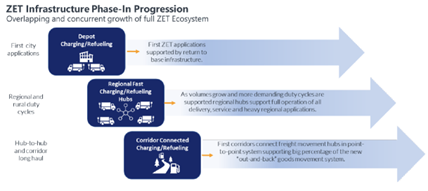As part of our work to assist Global Memorandum of Understanding (Global MOU) on Zero-Emission Medium- and Heavy-duty Vehicles (ZE-MHDVs) signatory countries meet the target of 100% zero-emission new truck and bus sales by 2040, Drive to Zero develops comprehensive guidance and resources that support the MOU countries’ implementation of impactful policies and programs. This month, we’ve published two briefing papers based on our first two invitation-only Thematic Deep Dive (TDD) webinars that provide key findings and critical next steps for governments to advance their ZE-MHDV ambitions.
- TDD Series 1: Technology Readiness and Economics of Technologies offers insights into the current state of ZE-MHDV technologies and their associated economics and strategies to drive rapid deployment of ZE-MHDVs. Battery-electric and fuel cell technology is available to match most duty cycles today, and select segments of ZE-MHDVs already demonstrate favorable total cost of ownership—the strategic and sequenced rollout of technologies and targeted deployments of capital and innovative financing mechanisms cannot wait. Learn more about the road to ZE-MHDV commercialization through coordinated stakeholder action.
- TDD Series 2: Zero-Emission Medium-and Heavy-duty Vehicle Infrastructure provides an overview of the kinds of technology available and specific actions that governments can take to ensure infrastructure growth accelerates at the pace of the ZE-MHDV market. Infrastructure is one of the largest barriers to a zero-emission future, and our briefing explains how to drive rapid deployment of zero-emission truck (ZET) infrastructure that supports the full zero-emission vehicle ecosystem.

Figure extracted from “Thematic Deep Dive Series 2: Zero-Emission Medium-and Heavy-duty Vehicle Infrastructure”
Access recordings of the TTD1 webinar and/or the TDD2 webinar on the Drive to Zero website, and stay tuned for the next edition in our TDD series.
— Cristiano Façanha, Global Director, CALSTART / Drive to Zero
Program Updates
Drive to Zero Welcomes New Global Program Manager
CALSTART is thrilled to welcome Samir Mulgaonkar as our new Drive to Zero Global Program Manager. Samir will lead and manage all of Drive to Zero’s global partner recruitment and engagement. He will also lead our infrastructure work and activities in India, including strategy and fundraising, policy advocacy, industry engagement, and vehicle deployment support. Samir joins CALSTART from California’s Department of Transportation, where he worked as an Innovation and Technology specialist, leading all zero- and low-emission projects. He has a great combination of subject matter knowledge on ZE-MHDVs and off-road intercity passenger rail, as well as experience with project management and comprehensive stakeholder engagement with many government agencies in California and the U.S., specifically on ZE-MHDVs.
Pledge Partner Updates
The Drive to Zero pledge partner network continues to grow, and we are excited to welcome the following organizations that recently signed the Drive to Zero Pledge:
The Drive to Zero pledge partner network now stands at over 135 partners working together to accelerate the market for ZECVs. Learn more about the Pledge on the Drive to Zero website.
News Updates
The urgency the world faces in curbing commercial transportation emissions cannot be stressed enough, especially given The ICCT’s assertion that the U.S. Environmental Protection Agency’s most stringent option for new emission limits on heavy-duty engines will result in over $4.8 billion in monetized health benefits annually by 2035 and disadvantaged communities will see 26%–27% greater than average reductions in particulate matter exposure. Drive to Zero’s research for the TDD series confirms that, like passenger cars, ZE-MHDVs meet the demands of most duty cycles today. Advancements such as technical prerequisites for future megawatt charging in new truck designs and innovators seeking to develop new batteries with a range of over 1,000 kilometers will soon help meet any performance demands.
While major global corporations are beginning to take advantage of the economics benefits ZE-MHDVs provide in select segments, like Amazon’s launch of e-cargo bikes in London, Walmart’s order of 4,500 Canoo electric transporters in the United States, and Glencore’s order of a full fleet of battery-electric mining equipment for use in Canada, financial incentives are still needed to build out the market. Small fleets, who face more difficult challenges with up-front costs, limited financing, and complex planning for charging, will now have the opportunity to apply for voucher requests through the California Air Resources Board’s Innovative Small e-Fleet pilot, and the Canadian federal government will also offer $100,000 to $150,000 per leased or purchased Class 8 truck.
This month also saw significant announcements on ZE-MHDV infrastructure: the U.S. has designated alternative fuel corridors across the country, and the Volvo Group, Daimler Truck, and the TRATON GROUP’s joint venture will install and operate at least 1,700 high-performance green energy charge points on highways and at logistics hubs across Europe. Other pilot projects nearing completion, such as California’s Investor-Owned Utility Transportation Electrification Priority Review Projects, will now help inform and improve the buildout of these massive charging networks – check out Energetics’ evaluation findings and lessons learned from California’s Transportation Electrification Programs.
Please share new information, potential partners, and innovative practices to achieve our Drive to Zero goals at info@globaldrivetozero.org. Follow us on Twitter @TeamDrivetoZero. Please feel free to share this newsletter with others.
– Emily Varnell, Technical Writer, CALSTART
News Digest
 |
Market |
 |
Fleet Deployments |
 |
Manufacturers and Models: Trucks and Buses |
 |
Government Policies |
 |
Financial Incentives |
 |
Fuels & Infrastructure
|
 |
Batteries & Technology |
